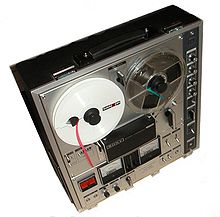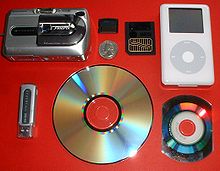
Back تخزين البيانات Arabic Storio data Welsh Datenspeicher German ذخیرهسازی داده Persian आंकड़ा भंडारण Hindi Penyimpanan data ID 데이터 스토리지 Korean Conservatio datorum Latin Duomenų saugojimas Lithuanian Spremišta podataka Serbian
This article needs additional citations for verification. (February 2018) |




| Computer memory and data storage types |
|---|
| Volatile |
| Non-volatile |
Data storage is the recording (storing) of information (data) in a storage medium. Handwriting, phonographic recording, magnetic tape, and optical discs are all examples of storage media. Biological molecules such as RNA and DNA are considered by some as data storage.[1][2] Recording may be accomplished with virtually any form of energy. Electronic data storage requires electrical power to store and retrieve data.
Data storage in a digital, machine-readable medium is sometimes called digital data. Computer data storage is one of the core functions of a general-purpose computer. Electronic documents can be stored in much less space than paper documents.[3] Barcodes and magnetic ink character recognition (MICR) are two ways of recording machine-readable data on paper.
- ^ a b Gilbert, Walter (Feb 1986). "The RNA World". Nature. 319 (6055): 618. Bibcode:1986Natur.319..618G. doi:10.1038/319618a0. S2CID 8026658.
- ^ Hubert, Bert (9 January 2021). "DNA seen through the eyes of a coder". Retrieved 12 September 2022.
- ^ Rotenstreich, Shmuel. "The Difference between Electronic and Paper Documents" (PDF). George Washington University. Archived from the original (PDF) on 20 February 2020. Retrieved 12 April 2016.